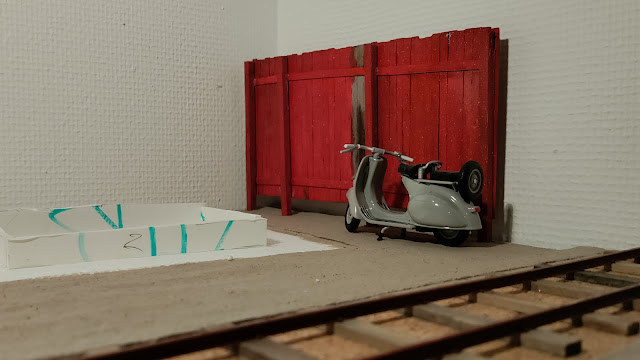During the last months I have from time to time built, painted and installed a humble wooden fence on my little layout. Not the most celebrated type of structure, but very fitting to the simple prototype I model. The fence is acting as a view blocker at the layout's right end. In that way it is possible to diminish a spectator's impression of the small layout abruptly coming to an end. Some careful work with a photo backdrop will hopefully help to produce a good result. Using structures to channel a spectator's view and to conceal the background can be expertly executed by talented modellers like Swedish Anders Runnholm in 1/35 scale. I'm inspired by the ingenuity and modelling and try to use some of the tricks on my own layout.
 |
| With the fuel shed removed the new fence is clearly visible. |
The fence was built from coffee stirrers on a framework from wooden profiles and assembled with standard PVA glue. I aimed for a slightly crooked appearance without it looking completely ready to overturn. When the glue had dried I painted the fence red with a few boards standing out in grey natural aged wood. The painted fence was then mistreated with a knife blade and sandpaper and a different shade of red painted over a few of the boards. The fence was then given a wash of heavily diluted dark brown oil paint. Once dry the fence module was coated with a layer of matt varnish from a spray can. I resisted the temptation of painting political slogans on the fence or fitting posters.
 |
| The fence during construction. The materials are ultra cheap: coffee stirrers bought in bulk and the wooden sticks used as tails in fireworks rockets picked up on a morning walk on New Year's Day. |
The fence is placed at a slight angle to the fuel shed to avoid structures and track all being at right angles to the baseboard edges. For the time being the fence is only fitted loosely into the holes poked in the soft baseboard. Once detailed ground cover, grass and vegetation are in place I may eventually glue the fence in place.


I've been doing something similar on my OO6.5 micro layout. What struck me was how much observation of the real thing is important even when building something as simple as this. I suspect location and date also come into it. A modern domestic fence is not the same as an industrial fence 100 years ago.
ReplyDeleteWell said, James. Observation and study of the prototype is essential to believable modelling. I'm probably a rather average modeller when it comes to actually making things in any scale. I'd rather be that, than an above average modeller with less attention to the prototype. My pet hate is model locos fitted with an array of handles with no obvious function and simply put there because the modeller thinks they look nice. But obviously a mix of both qualities are needed for any serious modeller.
ReplyDelete